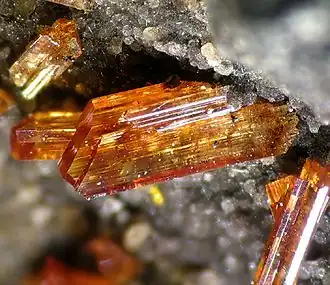Raspite
| Raspite | |
|---|---|
 | |
| General | |
| Category | Oxide minerals |
| Formula | PbWO4 |
| IMA symbol | Rsp[1] |
| Strunz classification | 4.DG.20 |
| Crystal system | Monoclinic |
| Crystal class | Prismatic (2/m) (same H-M symbol) |
| Space group | P21/b |
| Identification | |
| Colour | Light yellow, yellowish brown, grey |
| Crystal habit | Tabular (may have striations), elongate |
| Cleavage | Perfect {100} |
| Mohs scale hardness | 2.5–3 |
| Luster | Adamantine |
| Solubility | Decomposes in HCl |
Raspite is a mineral, a lead tungstate; with the formula PbWO4. It forms yellow to yellowish brown monoclinic crystals.[2] It is the low temperature monoclinic dimorph of the tetragonal stolzite.[2][3]
It was discovered in 1897 at Broken Hill, New South Wales, Australia, it was named for Charles Rasp (1846–1907), German-Australian prospector, discoverer of the Broken Hill ore deposit.[4]
See also
References
- ^ Warr, L.N. (2021). "IMA–CNMNC approved mineral symbols". Mineralogical Magazine. 85 (3): 291–320. Bibcode:2021MinM...85..291W. doi:10.1180/mgm.2021.43. S2CID 235729616.
- ^ a b Handbook of Mineralogy
- ^ Mindat entry
- ^ "Raspite Mineral Data", Webmineral.com, retrieved September 12, 2010
Bibliography
- Palache, P.; Berman H.; Frondel, C. (1960). "Dana's System of Mineralogy, Volume II: Halides, Nitrates, Borates, Carbonates, Sulfates, Phosphates, Arsenates, Tungstates, Molybdates, Etc. (Seventh Edition)" John Wiley and Sons, Inc., New York, pp. 1089–1090.